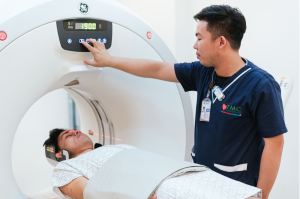A Computerized Tomography (CT) Scan is a modern diagnostic imaging technique used to examine internal parts of the body. It uses X-ray radiation emitted at various angles to produce a 3D-like image of the body’s internal structures. The results are instantly processed on a computer and can be analyzed by a radiologist. Because CT scans provide highly detailed images, they are considered one of the most effective and reliable methods for diagnosing conditions and diseases in virtually all parts of the body.
Who Needs a CT Scan and When Is It Used?
A CT scan can be performed on any patient based on a doctor’s recommendation. It is a versatile diagnostic tool used to detect various conditions, including:
- Bone and Muscle Injuries. CT scans can identify fractures, sprains, or other abnormalities in bones and muscles.
- Tumors, Infections, and Internal Bleeding. It helps pinpoint the exact location of tumors, infections, or blood clots within the body.
- Surgical and Treatment Guidance. Doctors use CT scans to assist procedures such as surgery, biopsies, and radiotherapy.
- Monitoring Diseases. Conditions like cancer, liver damage, and heart disease can be tracked to assess progression or improvement.
How Is a CT Scan Performed?

A radiation technologist assists in conducting the CT scan. The patient lies on a table attached to the scanner, which resembles a large ring or doughnut. As the circular scanner rotates, images of the body are captured from multiple angles and sent to a computer for processing.
In some cases, a contrast dye is used to enhance image clarity. This dye makes certain parts of the body, like blood vessels or organs, more visible. The contrast may be:
- Orally ingested. The patient drinks the contrast liquid.
- Injected. The dye is administered through a vein.
- Inserted rectally. The contrast is introduced into the rectum.
The process is quick and painless, often completed within a few minutes.
What Conditions Can a CT Scan Detect?
CT scans are capable of detecting numerous conditions affecting the body. These include:
- Bone and Muscle Issues. Fractures, infections, and injuries in bones, muscles, and joints can be easily diagnosed.
- Organ Abnormalities and Tumors. Specific organs such as the heart, liver, kidneys, gallbladder, pancreas, and brain can be examined for infections, tumors, or irregularities.
- Vascular Conditions. Blood clots, internal bleeding, or aneurysms can be accurately identified.
How to Prepare for a CT Scan
Before undergoing a CT scan, patients must inform the doctor of the following:
- Pregnancy. Radiation may harm an unborn child.
- Allergies. To avoid adverse reactions to the contrast dye.
- Medical Conditions. Conditions like diabetes or kidney issues need to be addressed.
Preparation tips include:
- Fasting. Patients may be asked to stop eating or drinking for a few hours prior, especially for scans involving the digestive tract.
- Following Instructions. Adhering to the doctor’s guidelines ensures accurate results.
How Long Does It Take to Get CT Scan Results?
Since the images are instantly processed by the computer, radiologists can often analyze the results within minutes or hours after the procedure. In some cases, printed reports are available on the same day.
Potential Effects of a CT Scan on the Body
CT scans expose the body to X-ray radiation, which carries a very low risk of cancer. Although a CT scan uses more radiation than a standard X-ray, the amount is carefully controlled and minimal, making the risk extremely small.
However, certain groups face higher risks:
- Pregnant Women. Radiation exposure can harm the developing fetus. In such cases, safer alternatives like ultrasound or magnetic resonance imaging (MRI) are recommended.
- Frequent Scans. Repeated exposure over time increases cumulative radiation levels, though modern technology minimizes this risk.
A CT scan is a powerful, non-invasive imaging tool that provides detailed images for diagnosing injuries, infections, and internal conditions. With proper preparation and safety precautions, it remains a vital procedure for early detection and effective treatment planning. If you are concerned about radiation exposure or preparation requirements, consult your doctor to ensure the process is safe and suitable for your needs.


